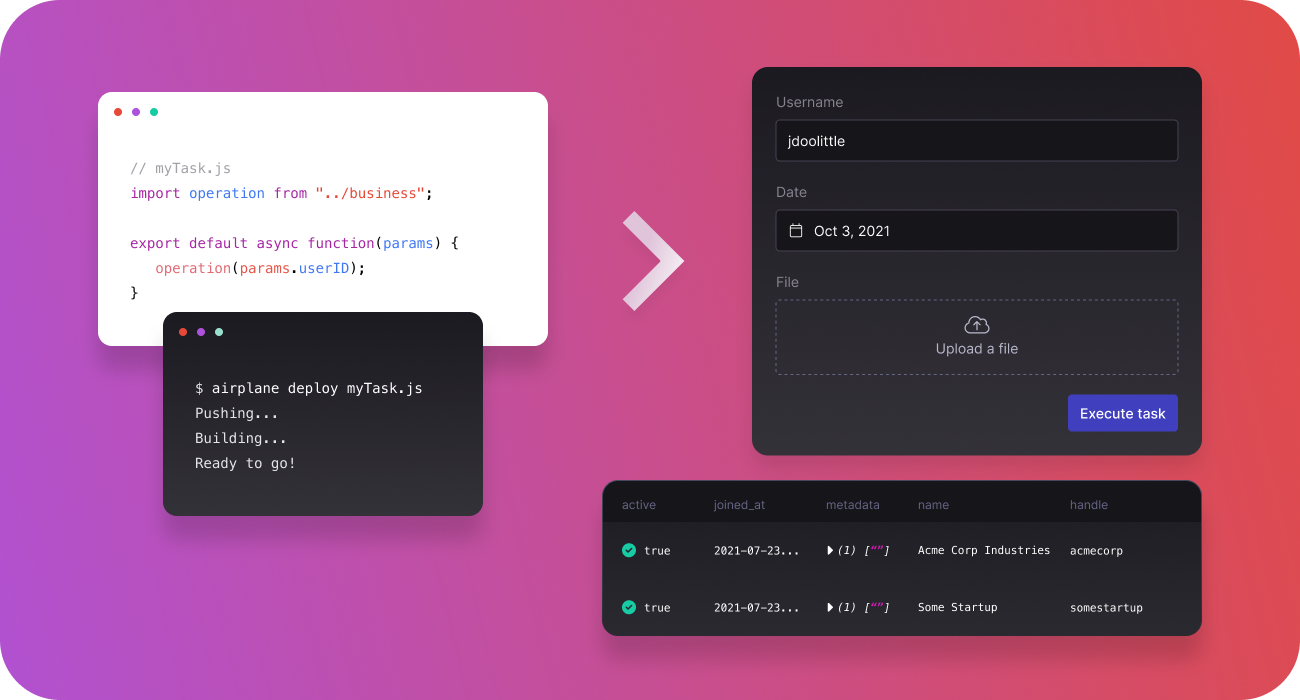Today, we're announcing our Series A and the public launch of Airplane runbooks—a developer platform for automating internal workflows.
The other half of the cloud
In 2021, "cloud software" or "SaaS" isn't a software category or industry vertical–it's a description of nearly every part of our lives. If you want to watch a movie at home, order a taxi, buy something, open a bank account, or book a doctor's appointment, you're almost always doing so through an app or website that requires an internet connection. And on the rare occasion that you call into the restaurant to make a reservation instead of using the OpenTable app, the person you chat with is just punching in your details into a cloud app on their end.
Every company needs an engineering team to build these apps. But the engineering team is also responsible for a whole mountain of other stuff–there's a massive amount of scaffolding and infrastructure, largely invisible to end users, to make cloud software work. A typical engineering organization might have 20-40% of their time spent on product engineering, but the remainder is spent on infrastructure, DevOps, internal tools, and more.
Over the last 10 years, the frameworks, platforms, and best practices for building customer-facing apps have improved significantly. But the other half of the cloud–all that hidden other stuff–has remained as messy as ever. Every company seems to have some mix of:
- Cron jobs running every few days, hours, or minutes keeping various systems in sync
- Internal wiki pages describing complex multi-step processes for common workflows
- Under-built internal admin panels for the support team to diagnose and fix issues
- Engineers constantly being asked to run one-off unsafe scripts and modify production data
Building a developer platform for enterprise software
At Airplane, we're building a platform that helps engineers manage this messy backend of cloud apps. We started with a simple but powerful abstraction: Airplane tasks. Tasks help transform duct-taped scripts and cron jobs into safe, reusable tools. An engineer can deploy a script to Airplane that represents a business operation that needs to be made accessible to others (e.g. deleting a user, spinning up a service, or canceling a pending money transfer).

In a couple minutes, Airplane makes it easy to overlay a web UI, notifications, input validation, permissions, approval flows, audit logs, and more.
Today, we're announcing the public availability of Airplane runbooks, which allow engineers to compose tasks and built-in integrations (SQL, REST APIs, Slack, and more) into complex, multi-step workflows. Now, you can rapidly build a workflow that runs your own JavaScript code, feeds that into a SQL database, combines data from Stripe, and Slacks out the results.

To see how Airplane works in a bit more depth, check out our demo video below:
If you're interested in trying it out, you can sign up for free today.
We're just getting started. Our vision is to build a powerful, integrated set of software primitives dedicated to building internal business systems. Over time, the Airplane platform will evolve further capabilities for persisting data, building interfaces, and more.
Our Series A funding
We started working on Airplane less than a year ago. Since then, hundreds of users have built and run tasks on Airplane, and we've grown the team to 10 people across 3 countries.
Today, we're announcing our $8.5M Series A funding round led by Benchmark with Eric Vishria joining our board. This will help us capitalize on our early traction, double the team size over the next year, and accelerate our vision towards a world-class enterprise software platform.
We're a remote-first team with hubs in San Francisco and New York. We're hiring product designers and software engineers—if you're interested, drop us a note at [email protected].



